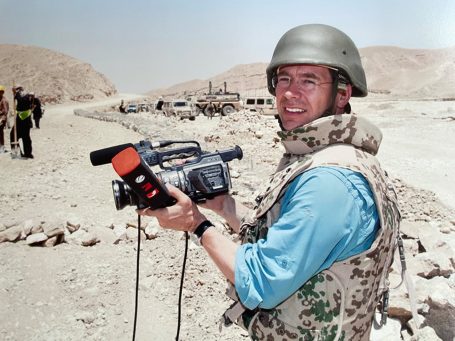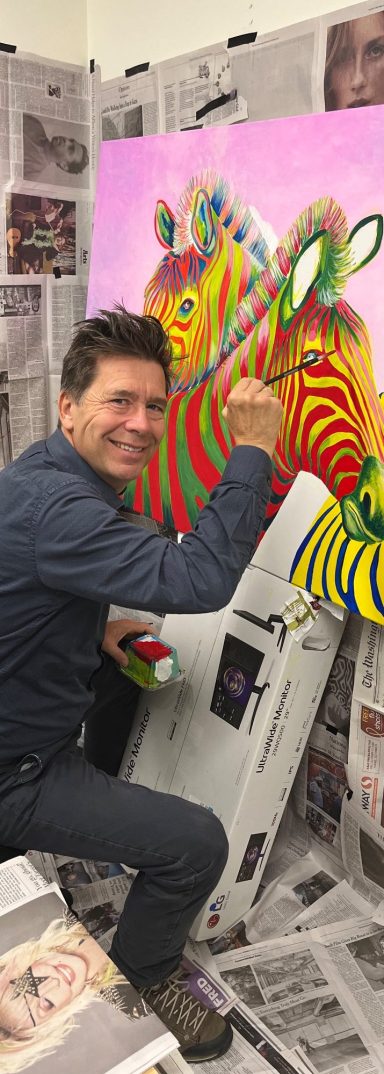Journalist Erdmann HUMMEL
Als TV-Reporter der Politikredaktion WeltN24 und Mitglied der Bundespressekonferenz berichte ich seit 2010 über die politischen Entwicklungen in Deutschland und der Welt. Zahlreiche Reportagen für Pro7Sat.1, N24 und Welt-Fernsehen aus Asien, Afrika und Australien gehören seit 2002 zu meinem Portfolio. 1993 gehörte ich dem Gründungsteam von n-tv an. Zuvor hatte ich an der Seite des Moderators und ehemaligen Spiegel-Chefredakteurs Erich Böhme die Sendung "talk im turm" als Redakteur betreut.





A Brushstroke against Tyranny
How a young painter outplayed East Germany’s Communists
Text written by Stephan Strothe, Journalist
The undercover Stasi agents were not exactly art lovers. Mingling among the visitors in an underground gallery in East Berlin, some tried hard to pretend some interest in the paintings along the gloomy walls of an abandoned butcher shop. But what the spies of the East German secret police had really come to see that day in 1988 were the people in the room – especially the 24 - year - old artist who had dared to set up this illegal gallery: Erdmann Hummel was not in line with the official communist art scene, that still favored variations of “Socialist Realism”. Erdmann’s paintings did not reflect that glorified view of the life of East Germany’s working class.
Working as a plumber and taxi driver during the day to make a living, he dabbled into various versions of pop art, “subversive art” in the eyes of the regime. That he exhibited the work of other banned painters made him even more threatening to the authorities.
Not being a loyal brush-wielding party member was not the only reason the Stasi had Erdmann Hummel in their sights.
The young artist had already shown his opposition to the Communist party’s rule by participating in demonstrations and clandestine meetings with likeminded pro-democracy activists.
Secretly, Erdmann had already decided to do what a growing number of East Germans had resorted to in the 1980s: he tried to “vote with his feet” and attempted to escape the totalitarian system by going over - or around - the Berlin Wall.
Together with a friend, Erdmann tried to flee across the Baltic Sea with their self-build windsurfer, but they soon realized that their board was not seaworthy enough for that risky route. Erdmann then tried to reach the West via other Eastern Bloc countries, but that, too, turned out to be a dead end. It landed one of his coconspirators in jail for years.
Finally, in January of 1988, he decided to officially request an exit visa. The East German authorities promptly arrested and imprisoned him.
West Germany’s government decided to include Erdmann in their latest cash-for-political prisoners-exchange, and just a year later, the Berlin Wall came crushing down.
The unified Germany first turned out to be a tough terrain for artists who had come over from “the East”. So, to survive financially, Erdmann started a new career in journalism, also to process his prevails over the regime on the other side of the wall.
He produced documentaries and covered the first free elections in the east as a reporter for Germany’s leading news channel N24 (now “Welt”).
All the while, Erdmann never gave up painting, and with several exhibits in Berlin, Brandenburg, and Lower Saxony, in 2014 he started the next phase of his career under his artist’s name “OERDY”.
Now, Erdmann Hummel is exploring the art scene on the other side of the Atlantic, coming to Washington, DC and Maryland’s Eastern Shore.

Warum Zebras?
Zebras sind pure Lebensfreude. Deshalb haben meine Zebras farbenfrohe Streifen als Ausdruck dieser Lebensfreude. Denn das Leben ist bunt und schön – ganz und gar nicht schwarz-weiß!
Ich bin Künstler, aber auch politischer Mensch. Zwei Jahrzehnte lang habe ich als Journalist über deutsche und internationale Politik berichtet. Als Reporter war ich in Afrika, Asien, in Krisengebieten wie Afghanistan, Irak oder Gaza. Und nirgends ist die Situation schwarz oder weiß. „Schwarz-Weiß-Denken“ steht für extremes oder undifferenziertes Denken – dagegen male ich mit meinen bunten Zebras.
Zebras sind rätselhaft. Bis heute ist das Geheimnis ihrer Streifen nicht vollständig gelöst. Offenbar täuschen sie ihre Feinde durch ihre besondere Fellzeichnung. Ein Löwe kann in einer Zebraherde kaum ein einzelnes Opfer fixieren. Das Gewirr ihrer Streifen schützt die Tiere vor ihren Räubern. Selbst Stechmücken lassen sich von Zebras verwirren. Die Streifen machen offenbar die Landung auf dem Fell so schwierig, dass Zebras deutlich seltener von diesen Blutsaugern befallen werden als Pferde.
Zebras sind unzähmbar. Schon vor hunderten Jahren haben englische, französische und deutsche Kolonisten in Afrika versucht, Zebras als Nutztiere zu halten. Es gelang bis heute nicht, sie wie Pferde zum Reiten oder wie Esel als Lastenträger zu domestizieren.
Zebras sind Individualisten. Kein Tier gleicht dem anderen. Genau wie der Fingerabdruck oder die Iris der Menschen hat jedes Zebra eine einzigartige Streifenzeichnung.
Zebras sind für mich ein Symbol der Freiheit. Diese Freiheit wandle ich in Farbenfreude um. Ihre Streifen geben mir als Maler die Möglichkeit, Komplementärfarben gegeneinander zu setzen.
Wir benötigen Ihre Zustimmung zum Laden der Übersetzungen
Wir nutzen einen Drittanbieter-Service, um den Inhalt der Website zu übersetzen, der möglicherweise Daten über Ihre Aktivitäten sammelt. Bitte überprüfen Sie die Details in der Datenschutzerklärung und akzeptieren Sie den Dienst, um die Übersetzungen zu sehen.